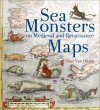![Seeungeheuer und Monsterfische Seeungeheuer und Monsterfische]()
Click to have a closer look
About this book
Customer reviews
Related titles
Recommended titles
About this book
Language: German
This is a German translation of Sea Monsters on Medieval and Renaissance Maps.
The sea monsters on medieval and Renaissance maps, whether swimming vigorously, gambolling amid the waves, attacking ships, or simply displaying themselves for our appreciation, are one of the most visually engaging elements on these maps, and yet they have never been carefully studied. The subject is important not only in the history of cartography, art, and zoological illustration, but also in the history of the geography of the 'marvellous' and of western conceptions of the ocean. Moreover, the sea monsters depicted on maps can supply important insights into the sources, influences, and methods of the cartographers who drew or painted them. In this highly-illustrated book the author analyzes the most important examples of sea monsters on medieval and Renaissance maps produced in Europe, beginning with the earliest mappaemundi on which they appear in the tenth century and continuing to the end of the sixteenth century.
Summary in German:
Riesenkraken, Menschenfresser, Monsterschildkröten: Egal, ob sie Schiffe angreifen, in den Wellen herumtollen oder Seeleute verschlingen, diese Kreaturen sind ein Blickfang auf den Karten des Mittelalters und der Renaissance. Damals sahen die Seeleute in ihnen eine reale Bedrohung aus den unbekannten Tiefen der Weltmeere. Heute sind die mystischen Wesen nicht nur für die Geschichte der Kartographie von großer Bedeutung, sondern auch für die Entwicklung von Kunst und zoologischen Darstellungen interessant. Darüber hinaus geben die phantasievollen Illustrationen Einblicke in die Methoden und Quellen der damaligen Kartographen als ein Abbild der geographischen und biologischen Kenntnisse ihrer Zeit. Chet van Duzer interpretiert in diesem üppig bebilderten Band zum ersten Mal Seeungeheuer auf den wichtigsten europäischen Karten: von den ersten Mappae mundi aus dem 10. Jh. über die frühen Globen bis hin zu den Kartendarstellungen des 16. Jh.s wie Mercators Weltkarte von 1569.
Customer Reviews



























